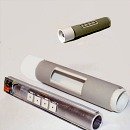Ann Makosinski is a 16-year-old student who competed against thousands of other young inventors from around the world to win first prize and a $25,000 scholarship at Google's International Science Fair.
She invented a battery-free flashlight. A free energy device that is powered by the heat in your hand.
While visiting the Philippines, Ann found that many students couldn't study at home because they didn't have electricity for lighting.
Unfortunately, this is a common problem for developing regions where people don't have access to power grids or can't afford the cost of electricity.
Ann recalled reading how the human body had enough energy to power a 100-watt light bulb.
This inspired her to think of how she could convert body heat directly into electricity to power a flashlight. She knew that heated conductive material causes electrons to spread outwards and that cold conductive material causes electrons to condense inwards.
So, if a ceramic tile is heated, and it's pressed against a ceramic tile that is cool, then electrons will move from the hot tile towards the cool tile producing a current.

Ann started using ceramic tiles placed on top of each other with a conductive circuit between them (known as Peltier tiles) to create the amount of electricity she needed for her flashlight.
Her idea was to design her flashlight so that when it was gripped in your hand, your palm would come in contact with the topside of the tiles and start heating them.
To ensure the underside of the tiles would be cooler, she had the tiles mounted into a cut-out area of a hollow aluminum tube.
This meant that air in the tube would keep the underside of her tiles cooler than the heated topside of the tiles. This would then generate a current from the hot side to the cold side so that light emitting diodes (LEDS) connected to the tiles would light-up.
But although the tiles generated the necessary wattage (5.7 milliwatts), Ann discovered that the voltage wasn't enough. So she added a transformer to boost the voltage to 5V, which was more than enough to make her flashlight work.
Ann successfully created the first flashlight that didn't use batteries, toxic chemicals, kinetic or solar energy, and that always works when you picked it up.
She credits her family for encouraging her interest in electronics and derives her inspiration from reading about inventors such as Nikola Tesla and Marie Curie.
She told judges at the Google competition that her first toy was a box of transistors.Time Magazine listed Ann as one of the 30 people under 30 who are changing the world.She is working on bringing her flashlight to market and is also developing a headlamp based on the same technology.

No comments:
Post a Comment